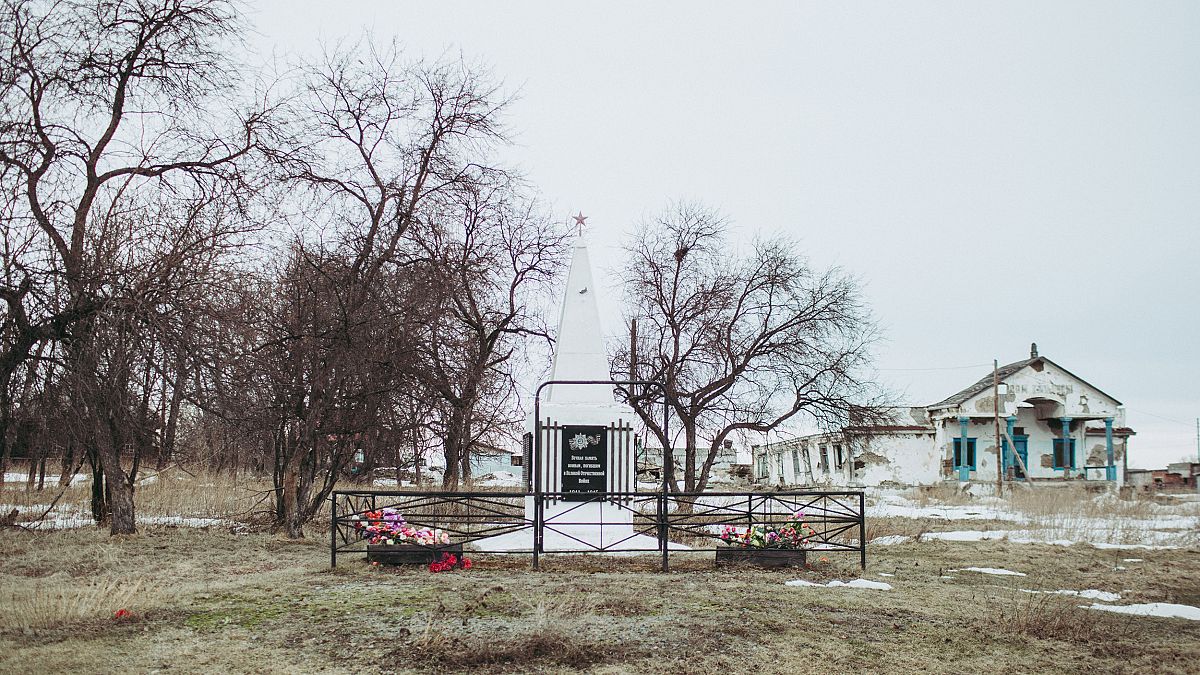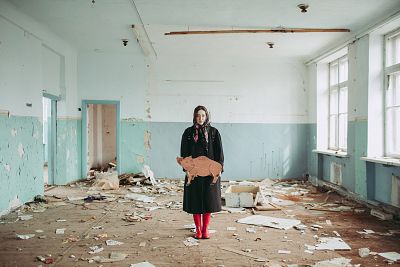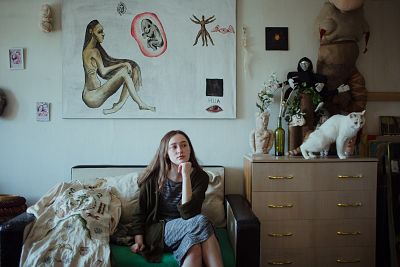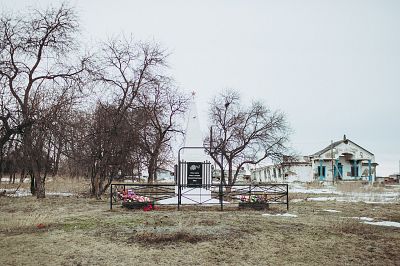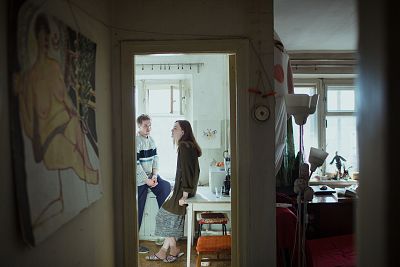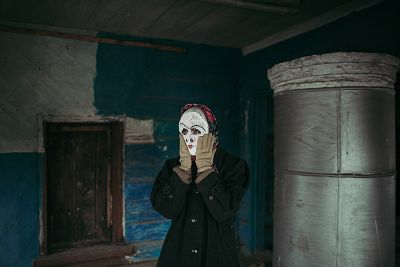Around 20,000 communities are now entirely abandoned, according to official figures. And 36,000 others have fewer than 10 residents each.
YAKSHINA, Russia — Broken glass cracks beneath Alisa Gorshenina's feet as she wanders through her old kindergarten.
Passing through the abandoned classrooms, she inspects and scavenges objects that might be useful for her art — broken toys, old posters, a large paper matryoshka nesting doll.
In the empty locker room, she tries to remember which of the compartments once belonged to her. "I think it had a fish on it," Gorshenina, 25, says.
Then she sets up her camera, puts on a mask, and poses against the painted murals in the rooms filled with scattered trash.
Many other public buildings and homes are in ruins in the village of Yakshina, where Gorshenina spent the first six years of her life.
The scenes of neglect would not look out of place in the Chernobyl nuclear exclusion zone or Andrei Tarkovsky's disturbing 1979 film, "Stalker."
Yakshina is one of Russia's dying villages. Around 20,000 are now entirely abandoned, according to official figures. Around 36,000 others have fewer than 10 residents each.
Years of economic and social malaise that have devastated Russia's rural communities are to blame.
Gorshenina's ghostly portraits of Yakshina have earned her recognition as one of the rising stars of Russia's art scene. She even had a solo exhibition at Moscow's VDNH, one of the Russian capital's most prestigious art spaces.
Her work mostly features herself in textile costumes and masks that she makes out of old bedding and curtains. It expresses both her childhood memories and Gorshenina's own take on the mythology of her home village.
For Gorshenina, the decline of Russia's rural heartland, and Yakshina in particular, is bound up with her family history.
Her mother, Tatyana, a city girl herself, moved to Yakshina for agricultural work experience when she was 18. She ended up falling in love and marrying Alexei Gorshenin.
"For me the village was very romantic, and I left everything behind and came there. At first it was all right, but it was difficult for a city person to get used to it," Tatyana Gorshenina told NBC News in her small, one-room home on the outskirts of Niznhiy Tagil, the industrial city where the family now lives.
The 1990s were hard for millions of Russians, with mass unemployment and shortages of basic essentials, including food.
#embed-20190424-yakshina-locator iframe {width: 1px;min-width: 100%}
It was a struggle to survive. Tatyana Gorshenina says that her family was saved from hunger by obtaining a cow, which provided them with some nourishment.
"It was such hard work. In the winter, there was stagnation and no money. The canteen where I worked was seasonal and would shut for winter. Things went from bad to worse," she recalls.
Alisa Gorshenina remembers a difficult childhood in Yakshina. She was bullied and beaten for having a funny name — "Alisa" is not typical in Russia — and for looking different.
"I dreamed of leaving the village," she says. "Mom told me about Nizhny Tagil and we would come here to visit relatives. And to me, as a child, it seemed full of these huge castles, it was like a fairy tale."
In 2000, Tatyana Gorshenina eventually persuaded her husband that there was no future for them or their two daughters in Yakshina. The family moved to Nizhny Tagil, the factory town of 350,000 people located a three-hour drive away.
The exodus from Yakshina has yet to subside. Locals say around 500 people called it home when the Gosheninas left. By 2010, the official census put its population at 435. And while around 300 residents are now registered in the village, officials says fewer than 200 actually live there.
But her time there as a child continues to influence Alisa Gorshenina — and Yakshina is central to her work.
"The image of the village is not serene," the artist explained as she picked her way through deserted rooms of her former school. "The image of the village is of a drunk man … of poor women who take everything on, including their drunken husbands, who take care of the livestock, and do all the dirty work, as well as their regular jobs."
'Life is vanishing'
Yakshina sits almost exactly on the border of Asia and Europe, around 1,200 miles east of Moscow in the Sverdlovsk region.
Lubov Evdokimova, 51, is one of the few remaining villagers. She lives in an apartment opposite to the one where Alisa Gorshenina grew up, and worked at the local school for 15 years before it was closed down.
Evdokimova is now a social worker who also helps to conduct the census. She says that the majority of the residents of Yakshina are elderly. Most younger people, including her own children, have left in search of work.
"There is no future here," she said. "It's all on the verge of collapse. Soon the whole village will be made up solely of retirees."
Evdokimova's husband, Vladimir, is unemployed after losing his job when the local Soviet-era collective farm shut. Perhaps, she reflects, they should also have given up on Yakshina, but her sick parents and livestock now keep her there.
Similar bleak scenarios are also playing out in thousands of other villages across Russia.
"In some places, life is vanishing, but it at the same time it is concentrating around the large [city] centers," said Tatyana Nafedova, the co-author of a recent study on rural decline for the Demographics Institute at Moscow's Higher School of Economics.
Nafedova and her co-author, Nikita Mikrtchan, found that around 200,000 people each year leave Russia's villages to find employment and better living conditions in towns and cities.
The decline of the countryside began with the rapid urbanization during the Soviet period. "The USSR began with 85 percent of its population residing in the countryside, and ended with 74 percent of them as city dwellers," their study notes.
Since the collapse of the Soviet Union in 1991, many of the collective farms that replaced peasant farming as the economic mainstay of rural areas have shrunk or simply closed. Unemployment in Russia's rural areas now ranges from 30 percent to 55 percent.
Conjuring ghosts
Alisa Gorshenina's father found employment at the local steelworks after the artist's family moved to Nizhny Tagil. But the pay was abysmal and they still struggled to survive.
Alisa Gorshenina soon became disillusioned with city life, and found it frightening to be left alone in their small apartment while her parents worked hard to make ends meet.
She also found it hard to make new friends and found herself once again the subject of ridicule at school. But her struggle drove her to be more ambitious and creative.
"At that young age, I already had this desire not for revenge, but to do something that would earn respect," she said. "I needed to prove something."
After attending an art institute in Nizhny Tagil, Alisa Gorshenina's work started getting attention from curators across the country.
She was accepted to a modern art school in Moscow, but found the frantic capital city stressful and life there uninspiring.
So Alisa Gorshenina returned to Nizhny Tagil, where she says she has all she needs in a tiny rundown apartment that she shares with her husband, Sergei.
But although Alisa Gorshenina says her work reflects her own inner world, the images also conjure up the ghosts of the dying Russian countryside.
And although she has few ties to Yakshina now, Alisa Gorshenina still dreams of being able to spend long stretches of time in the village — perhaps even opening a museum there someday.
"It's a sacred place for me," she said.
